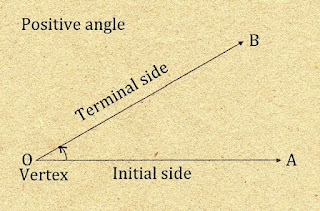ANGLES AND ITS DIFFERENT UNITS

Angle is a measure of rotation of a given ray about its initial point. The original ray is called the initial side and the final position of the ray after rotation is called the terminal side of the angle. The point of rotation is called the vertex. If the direction of rotation is anticlock, the angle is said to be positive . If the direction of rotation is clock, then the angle is negative . The measure of an angle is the amount of rotation performed to get the terminal side from the initial side. There are several units for measuring angles. Degree measure If a rotation from the initial side to terminal side is ( 1/360 )th of a revolution, the angle is said to have a measure of one degree ( 1° ). A degree is divided into 60 minutes ( 60' ). A minute is divided into 60 seconds ( 60" ). One sixtieth of a degree is called a minute, i.e. 1', and one sixtieth of a minute is called a second, i.e. 1". Thus, 1° = 60' , 1' = 60...
